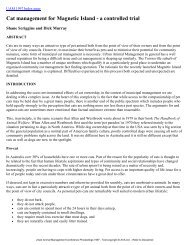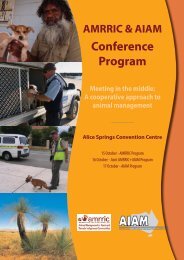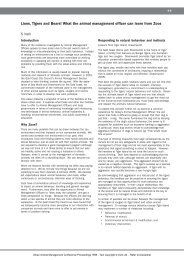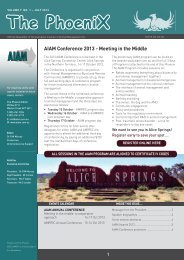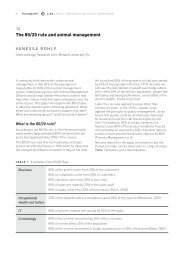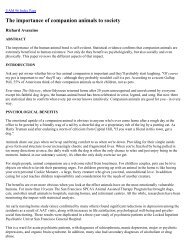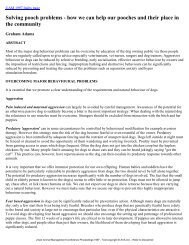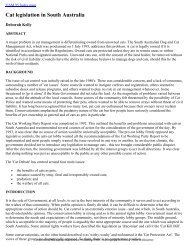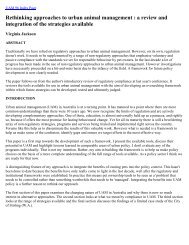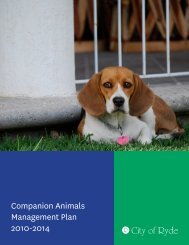Proceedings OF ThE - Australian Institute of Animal Management Inc
Proceedings OF ThE - Australian Institute of Animal Management Inc
Proceedings OF ThE - Australian Institute of Animal Management Inc
Create successful ePaper yourself
Turn your PDF publications into a flip-book with our unique Google optimized e-Paper software.
24 <strong>Proceedings</strong> 2012<br />
AIAM Annual Conference on <strong>Animal</strong> <strong>Management</strong><br />
03<br />
Invisible paws in human affairs<br />
David Paxton<br />
Veterinarian<br />
“Responsible pet ownership” is a paradigm that<br />
prescribes the Three Rs <strong>of</strong> control – registration,<br />
regulation and remonstration – but does not address<br />
the complicated, subjective relationship we share<br />
with other animals in the urban environment. A<br />
naturalistic perspective helps to do so by seeing the<br />
urban environment as a shared, evolving ecosystem.<br />
Native <strong>Australian</strong> wildlife is adapting to the built<br />
urban environment. Its management is a potentially<br />
rich opportunity for <strong>Animal</strong> Managers. However the<br />
invisible paws which give this paper its name, are<br />
those <strong>of</strong> the dog and cat.<br />
Back scratching<br />
Adam Smith wrote the influential An Inquiry into<br />
the Nature and Causes <strong>of</strong> the Wealth <strong>of</strong> Nations in<br />
1776. He argued that it is human nature to act in<br />
one’s self-interest but, in doing so, each individual<br />
is led by an invisible hand to act for the greater<br />
good <strong>of</strong> the society. Thus the baker who bakes in<br />
his self-interest also acts in the interests <strong>of</strong> the<br />
consumer who, in turn also acts in the interests <strong>of</strong><br />
the baker when buying bread to assuage his hunger<br />
selfishly. For Smith, the invisible hand explained<br />
inner-connectedness and bonding, and natural selfregulation<br />
in society.<br />
This paper speculates similarly: Human natures,<br />
dog natures and cat natures, although each working<br />
out <strong>of</strong> self-interest, are led as though by the invisible<br />
hands and paws <strong>of</strong> co-evolution to promote the<br />
interests <strong>of</strong> the complex naturally.<br />
Original din<br />
In 1994, at the Third Urban <strong>Animal</strong> <strong>Management</strong><br />
Conference, I argued that the relationship between<br />
people and dogs is evolved; it was not just a recent<br />
human-mediated incident (Paxton 1994). I speculated<br />
that dogs and people co-evolved from some<br />
130,000 years ago in a complex <strong>of</strong> animals that was<br />
biologically cooperative internally and successfully<br />
competitive externally.<br />
The evolution <strong>of</strong> the anatomy for speaking words by<br />
quirky humans was possible because we learned to<br />
depend on sentinels – dogs. Evolution <strong>of</strong> the equally<br />
quirky dog was possible within the protection <strong>of</strong><br />
the human cave. The evolution <strong>of</strong> each species was<br />
blended from the beginning, such that each became<br />
part <strong>of</strong> the other’s nature. They were extended<br />
phenotypes and, together, out-competed their own<br />
cousins, including the physically gifted Neanderthal.<br />
In 2011 the idea was published in detail in my book<br />
Why It’s OK to Talk to Your Dog (Paxton 2011). Over<br />
the years since the third conference, my idea<br />
arguably has been supported by DNA evidence;<br />
by the validation <strong>of</strong> 30,000+ years-old skulls <strong>of</strong> dogs<br />
in Belgium and Siberia; by the idea that Homo<br />
evolution may have been multi-regional within Africa<br />
(Christopher Stringer 2011); and by fresh thinking<br />
on the mechanisms <strong>of</strong> evolution, especially<br />
regarding mutualistic symbionts (see, for example,<br />
Frank Ryan 2009).<br />
The social structures <strong>of</strong> animals evolve naturally.<br />
The ability to enunciate words enabled people to<br />
evolve very complex social structures, or cultures,<br />
based on myths, traditions, theories: that is, stories.<br />
These stories told us that we are God-like or uniquely<br />
self-determinant. Rudyard Kipling (1902) was an<br />
example <strong>of</strong> an influential story-teller whose ideas<br />
on our relations with animals persist in popular<br />
forms today.<br />
“I am the cat who walks by myself, and<br />
all places are alike to me”<br />
In his Just So Stories, Kipling portrayed the cat as<br />
alo<strong>of</strong> and self-contained, but susceptible to the<br />
comforts <strong>of</strong> the human cave. He saw people’s caves<br />
attracting cats with lots <strong>of</strong> mice, warm fireplaces and<br />
bowls <strong>of</strong> milk. There was a sort <strong>of</strong> naturalism there,<br />
but anthropocentric wishful thinking also.<br />
I suggest that our caves provided self-contained<br />
ecosystems in which domesticatable cats could have<br />
their kittens, with greater security and success <strong>of</strong><br />
survival than in the wild outdoors. In our caves, the<br />
ancestral cat became the species we know.<br />
According to Carlos Driscoll et al 2009a, using<br />
mitochondrial DNA analysis, an ancestral cat<br />
branched into Felis silvestris lybica and the



